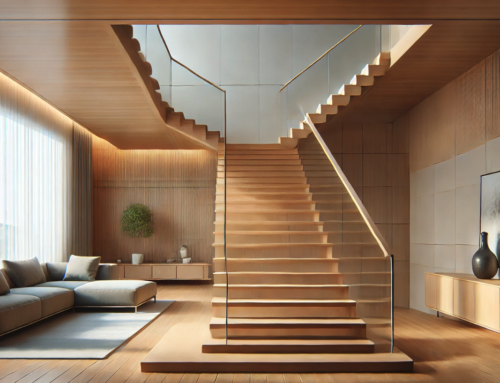Shocking Facts About UK Residential Staircase Regulations!

If you’re a homeowner, you know how much effort goes into keeping your home safe and up to standard. But did you know that your staircase might be one of the most regulated parts of your house?
That’s right! The UK has stringent regulations for residential staircases to ensure safety and accessibility. As a professional remodeling expert at Continox, I’ve seen firsthand how crucial it is to adhere to these regulations. Let’s dive into some shocking facts about UK residential staircase regulations and how they impact your home.
The Importance of Staircase Regulations
Why Do We Have Staircase Regulations?
Staircases can be a hidden hazard in many homes. According to the Royal Society for the Prevention of Accidents (RoSPA), falls are the most common cause of accidents in the home, with many of these occurring on stairs. These regulations exist to prevent accidents and ensure that everyone, from young children to the elderly, can use stairs safely.
Real-Life Example
I once visited a home where the staircase had been beautifully remodeled but didn’t meet the required regulations. The homeowners loved the aesthetic but had noticed an increase in minor accidents, especially with their young children. Once we adjusted the stairs to meet UK standards, those accidents stopped. It’s a prime example of how essential these regulations are.
Key Components of UK Residential Staircase Regulations
Understanding these regulations can be complex, but it’s vital for the safety of your home. Let’s break down the key components.

Height and Width Requirements
Height and width are the foundation of safe stairs. According to UK Building Regulations, the rise (height of each step) should be between 150mm and 220mm, and the going (depth of each step) should be a minimum of 220mm. The width of the staircase should be at least 800mm for comfortable use.
Personal Tip: When designing your staircase, think about who will be using it most. Wider stairs can be beneficial if you have a large family or frequently carry items up and down.
Tread and Riser Standards
The tread and riser dimensions are critical for safety. The regulations stipulate that the maximum rise is 220mm, and the minimum tread is 220mm. This ensures each step is uniform, reducing the risk of tripping.
Anecdote: I once helped a couple renovate their Victorian home. The original stairs were steep and narrow, making them a challenge to navigate. By updating them to current standards, we not only improved safety but also added to the home’s charm and value.
Handrail and Guardrail Specifications
Handrails and guardrails are more than just decorative elements; they’re essential for safety. UK regulations require handrails to be between 900mm and 1000mm in height on the stair pitch line. Guardrails must be able to withstand a horizontal force to prevent falls, especially in homes with children or elderly residents.
Interesting Fact: The spacing between the spindles of a guardrail should not exceed 100mm to prevent small children from slipping through.
Headroom Clearance
One often overlooked aspect is headroom clearance. The regulations require a minimum headroom of 2 meters above the pitch line of the stairs. This prevents head injuries and ensures comfort when using the stairs.
I recall a client who had installed a beautiful spiral staircase leading to a loft. However, the headroom was inadequate, making it uncomfortable and dangerous. We reworked the design to meet the 2-meter clearance, significantly improving the safety and usability of the space.
Common Mistakes Homeowners Make
Ignoring Building Codes
One of the most common mistakes is simply ignoring the building codes. Whether it’s due to a lack of knowledge or attempting to cut costs, non-compliance can lead to significant safety risks and legal issues.
DIY Projects Gone Wrong
DIY projects can be rewarding, but staircases are best left to professionals. Incorrect measurements, poor materials, and inadequate structural support are common pitfalls.
Overlooking Regular Maintenance
Staircases require regular maintenance to remain safe. Loose handrails, worn treads, and unstable steps can develop over time.
Tip: Schedule regular inspections and maintenance to keep your staircase in top condition. Continox offers comprehensive inspection services to ensure your stairs remain safe and compliant.
The Role of Professional Design and Installation
Benefits of Hiring Professionals
Hiring professionals like Continox ensures that your staircase is not only beautiful but also safe and compliant. Our expertise in designing and manufacturing custom staircases means we can handle everything from initial design to final installation, ensuring adherence to all regulations.
Example: One of our clients had a dream of a grand staircase in their newly built home. By working with Continox, they achieved their vision while ensuring the staircase met all UK regulations, providing both beauty and peace of mind.
Ensuring Compliance
Professionals ensure that every detail, from tread depth to handrail height, meets the required standards. This not only ensures safety but also avoids potential legal issues down the line.
Why Choose Continox: Our team at Continox is dedicated to creating staircases that are both functional and aesthetically pleasing. We stay updated on all regulations to guarantee compliance.
How Continox Can Help
Our Services
At Continox, we specialize in designing and manufacturing custom staircases that meet all UK regulations. Our services include:
- Custom Design: Tailored to your home’s style and your personal preferences.
- Manufacturing: Using high-quality materials for durability and safety.
- Installation: Expertly fitted to ensure compliance and longevity.
Case Studies
Client Success Story:
We recently worked with a family renovating their old farmhouse. They wanted a rustic yet modern staircase. By collaborating closely with them, we created a staircase that perfectly matched their vision and met all safety standards. Their feedback? “We never realized how much peace of mind a properly designed staircase could bring.”
Customer Satisfaction
Our commitment to customer satisfaction means we don’t just meet expectations; we exceed them. We provide ongoing support and maintenance to ensure your staircase remains safe and beautiful for years to come.
Steps to Take If Your Staircase Doesn’t Meet Regulations
Assess the Situation
First, assess the current state of your staircase. Identify areas that don’t meet the regulations, such as tread depth, handrail height, or overall structural integrity.
Consult a Professional
Consult with a professional, like those at Continox, to get an expert opinion. We can help you understand the necessary changes and provide a detailed plan for bringing your staircase up to code.
Plan the Renovation
Plan the renovation with safety and compliance in mind. This may involve replacing non-compliant parts, reinforcing structural elements, or even redesigning the staircase entirely.
Why Continox: Our team can guide you through this process, ensuring that all changes are both compliant and enhance the overall aesthetic of your home.
Implement the Changes
Implement the changes with the help of professionals. This ensures that all work is done to the highest standards and meets all regulatory requirements.
Tip: Always request a final inspection to ensure that all work is compliant and that your staircase is safe for use.
By understanding and adhering to UK residential staircase regulations, you can ensure that your home is both safe and stylish. And remember, Continox is here to help you every step of the way, from design to installation and beyond. Let’s make your staircase the safest and most beautiful it can be!



